R813 – L’Enfant au chapeau de paille, 1896 (FWN520)
RW480 – L’Enfant au chapeau de paille, 1896
RW481 – L’Enfant au chapeau de paille, 1896
RW482 – L’Enfant au chapeau de paille, 1896
RW483 – L’Enfant au chapeau de paille, 1896
Pavel Machotka
(Cliquer sur l’image pour l’agrandir)
Le portrait d’un petit enfant, probablement fait en 1896 pendant la visite de Cézanne à Talloires, où il a peint Le Lac d’Annecy, est aussi simple de construction et, presque comme le paysage, sans la moindre suggestion d’une signification extérieure. J’avoue être fasciné par le tableau sans tout à fait être capable de dire pourquoi. Ses nombreuses lignes droites sont certainement troublantes dans un portrait qui décrit un très petit enfant (qu’il ou elle soit petit(e) est manifeste, au vu de quatre études à l’aquarelle où sa taille réelle est évidente), et l’aplatissement des plis de la blouse prive curieusement le personnage de gaieté et de substance ; les épaules peintes simplement, à l’inclinaison forte, relevées pour priver le personnage de son cou, sont beaucoup moins compréhensibles ici que dans le tableau La Vieille au chapelet. Cependant toutes ces lignes se dirigent vers le visage, et c’est peut-être pourquoi elles sont si droites. Le visage est peint avec délicatesse, au moyen de touches sures d’elles, en une seule couche de pigment liquide, semble-t-il, d’un rose violet subtil sur un champ d’orange ; cela fait du visage une zone unifiant les couleurs du costume et de la partie gauche du fond. C’est peut-être cet arrangement formel, ce contraste entre le visage innocent de l’enfant et la géométrie qui l’entoure qui est si touchant. Et « touchant » n’est pas le mot juste ; la composition est en fait pleine de tension, avec une poussée asymétrique vers la gauche dans le regard, une déformation dans l’ovale du visage et du chapeau, une bosse dans la manche droite, et une projection vers l’avant de la boiserie. C’est une asymétrie à laquelle nous nous adaptons bien trop rapidement et il nous faut le voir dans un miroir pour renouveler notre jugement. Finalement ce sont ces contradictions voulues, cette conjugaison paradoxale de la tendresse et de l’art de Cézanne, qui font la force du tableau.
_______
A portrait of a small child probably done in 1896 during Cézanne’s visit to Talloires, where he painted Le Lac d’Annecy, is also simple in its construction and, almost like the landscape, without the slightest suggestion of external meaning. I confess to being fascinated by the painting without quite being able to say why. Its many straight lines are certainly puzzling in a portrait depicting a very small child (that he or she is small is clear from four watercolor studies where the real size is obvious), and the flattening of the folds of the smock curiously deprives the figure of playfulness and substance; the simply painted, sharply sloping shoulders, raised to deny the figure its neck, are less understandable here than in the La Vieille au chapelet painting. Yet all these lines point to the face, and this may be why they are so straight. The face is painted very delicately, with sure touches of what seems to be a single layer of liquid pigment, in a subtle violet-pink on a field of orange; this makes the face a unifying area for the colors of the smock and the left background. It is perhaps this formal arrangement, this contrast between the child’s innocent face and the geometry of what surrounds it, that is so touching. Nor is “touching” an adequate word; the composition is in fact full of tension, with an asymmetrical leftward thrust in the gaze, a distortion in the oval of the face and the hat, a bulge in the right sleeve, and a forward projection in the woodwork. It is an asymmetry we adapt to altogether too quickly and must see in the mirror to appreciate afresh. Ultimately it is these willful contradictions, this paradoxical joining of Cézanne’s tenderness and craft, that must account for the painting’s strength.
Source: Machotka, Cézanne: the Eye and the Mind.
Noter qu’il existe également un autre tableau et un dessin sur ce thème :
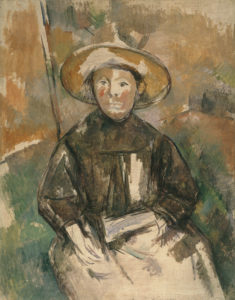
L’Enfant au chapeau de paille
vers 1902
R895-FWN537

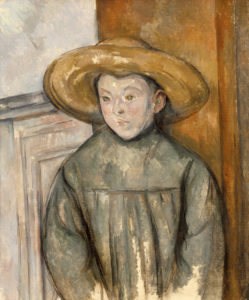
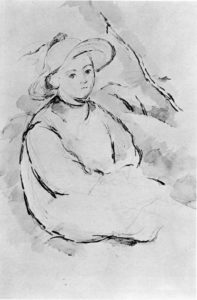

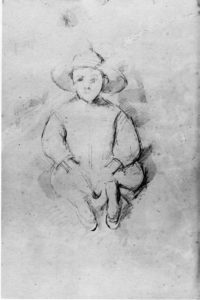
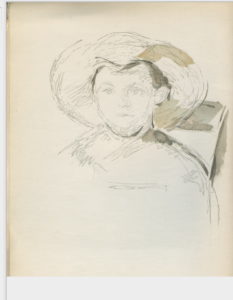
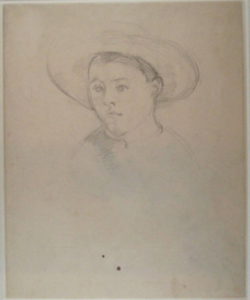

Vous devez être connecté pour poster un commentaire.